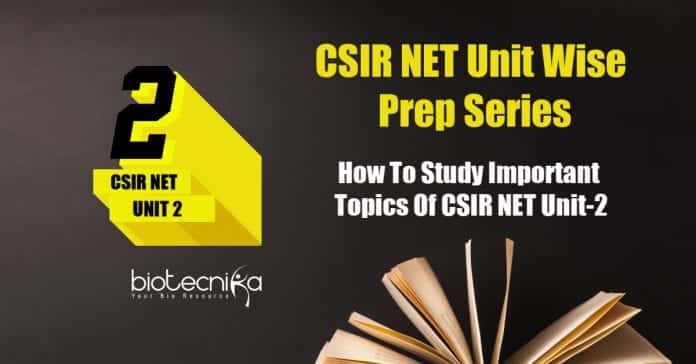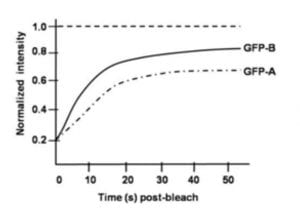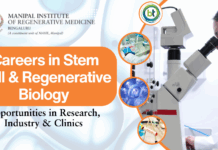CSIR NET Unit 2 Important Topics – How To Prepare CSIR UNIT 2
CSIR NET exam is one of the most difficult exams which apart from providing a Ph.D. degree, gives stipend and above all respect in the scientific community. Believe me, though it is one of the toughest exams if a student prepares for it in a strategic manner, one can easily qualify the exam in his/her first attempt.
Diving into the main topic, There are 13 units in the CSIR-NET Life Science exam, and today we will focus on how to prepare for Unit 2.
Most of the topics in this unit are easy to comprehend as there are vivid diagrams and process explanations in standard reference books.
Let’s have a look at the Syllabus of CSIR NET Life Science Unit 2 – Cellular organization
A) Membrane structure and function – Structure of model membrane, lipid bilayer and membrane protein diffusion, osmosis, ion channels, active transport, membrane pumps, mechanism of sorting and regulation of intracellular transport, electrical properties of membranes.
B) Structural organization and function of intracellular organelles – Cell wall, nucleus, mitochondria, Golgi bodies, lysosomes, endoplasmic reticulum, peroxisomes, plastids, vacuoles, chloroplast, structure & function of the cytoskeleton
and its role in motility.C) Organization of genes and chromosomes – Operon, unique and repetitive DNA, interrupted genes, gene families, the structure of chromatin and chromosomes, heterochromatin, euchromatin, transposons.
D) Cell division and cell cycle – Mitosis and meiosis, their regulation, steps in cell cycle, regulation, and control of cell cycle.
E) Microbial Physiology – Growth yield and characteristics, strategies of cell division, stress response.
Now, with the syllabus in hand, let us first understand the question paper pattern – In CSIR NET Dec 2019, the overall Difficulty level from unit 2 was around 30%, so we can conclude that the questions from this unit were not very difficult. Therefore, studying in a well-planned manner can help in solving questions from this unit easily. Most of the questions come from parts A, B, C, and D. The type of questions asked are always direct, though some numerical questions are also asked, at times.
Plan a study schedule:
- Managing your time effectively during the exam preparation is one of the keys to success.
- There are 5 subunits out of which the C and E are very small topics.
- Every day keep aside 2 hours for Unit 2
- For each subunit keep two days so in this way in 10 days you can easily grasp, memorize and finish the unit.
- Take important topics at first and when you complete a topic, revise it instantly.
- Question-solving is an important aspect in polishing your skills and improving exam performance.
- Every day after studying try to solve at least 10 questions from previous year question papers
Topics To Be Studied From CSIR NET Unit 2
As the exam syllabus is vast, it is always advisable to analyze the previous year’s question papers and select those topics from which questions are frequently asked. Cellular organization carries an overall 25-30 marks in the CSIR-NET exam.
CSIR Unit 2 preparation should be in such a way that one knows all about the cellular structures, their function, composition, division of cells, the molecular mechanism involved among others. For performing well with better learning practices, avoid cramming and mugging but one should focus more on understanding the topics, actual meanings, methods, and functions.
Membrane structure and function
- One should study in detail about the structure, composition of membranes in detail, the different types of phospholipids and proteins involved, their asymmetric distribution in the membrane.
- The role of lipid rafts is also important as many part C and part B questions are asked from the same.
- The RBC membrane components should also be studied including Band 3.
- One should not miss the FRAP techniques as Part C questions are asked related to FRAP. Sometimes the questions are clubbed with unit 13 and asked.
- It’s very important to memorize the types of ion channels, pumps, and transporters, their inhibitors, the mode of inhibition, their role in diseases as many part B questions are related to this topic
- One should also study the membrane destabilizing agents, detergent treatments as experimental based questions are expected in Part C
- Sorting of various proteins, mostly the entry of proteins into mitochondria is a must type of question from Part C.
- Membrane potential causes leading to changes in the potential, numerical related to it are asked in part C.
Structural organization and function of intracellular organelles
- Part B questions are asked from the cytoskeletal components like actin, dynein, kinesin, the direction in which they carry cargo and their function in different cellular processes.
- Enzymatic contents of cellular organelles like Golgi, lysosomes, peroxisomes, diseases associated with their impaired functions are very important from this subunit.
- Sometimes protein modifications in ER and cellular fractionation based questions are also asked.
Organization of genes and chromosomes
- This subunit is related to molecular biology, so to master over Unit 3, you should study this subunit.
- Questions are asked from Operon (Lac operon, Tryptophan operon, Arabinose operon), one should study in detail about the components and regulation of these operons in the presence or absence of their substrate.
- Statement based questions are asked in part C from Chromosome structure, transposons, Chromosome packaging
- Part B questions are asked from repetitive DNA sequences, centromeric regions, DNA acetylation, methylation so one should know the terms with examples if any.
Cell Division & Cell Cycle
- One should always study this subunit D of Unit 2 as it is connected with Cancer and apoptosis topic of Unit 4
- One should study the cell cycle progression, checkpoints regulation in detail, the different types of cyclins and CDKs along with their specific role.
- ATM, ATR, inhibition drugs and proteins and genes that control the cell cycle.
- In Part B many times questions are asked from DNA vs chromosome count for each stage of mitosis and meiosis. So one should know the mitosis and meiosis division accurately
Microbial Physiology
- From this subunit, one should expect some numerical questions based on microbial growth kinetics, diseases caused by different microbes, and stress response.
Reference Books for UNIT 2
- Cell and Molecular Biology: Concepts and Experiments by Gerald Karp
- Molecular Biology of the Cell by Bruce Alberts, Alexander Johnson, Julian Lewis
- Molecular Cell Biology by Harvey Lodish, Arnold Berk, Chris A. Kaiser
- Prescott’s Microbiology by Joanne Willey, Linda Sherwood, Chris Woolverton
- Brock Biology of Microorganisms
Now let’s Have a look at types of questions asked from Unit 2
If you carefully study the above topics one can then easily solve the different types of questions as shown below:
- Graph-based questions
Q. To investigate the dynamic nature of two unrelated centrosome-localized GFP-tagged proteins [GFP-A; GFP-B], a team of scientists conducted fluorescence recovery after photobleaching (FRAP) experiment. The FRAP profile of these two proteins is given below:
The following statements for this FRAP analysis were made
A. GFP-B shows faster exchange rate than GFP-A
B. GFP-A shows faster exchange rate than GFP-B
C. GFP-A has more immobile fraction than GFP-B
D. GFP-B has more immobile fraction than GFP-A
Which of the above-mentioned statements for GFP-A and GFP-B are correct?
1. A and C
2. A and D
3. B and C
4. B and D
To solve the graph-based questions one has to know the techniques accurately and analyze the graph appropriately. It might feel a little difficult but actually, if you practice these types of questions it can be easily solved.
CSIR NET Unit Wise Prep Series: How To Prepare CSIR NET Life Sciences UNIT 1
- Experiment Based Questions
Q. In order to study the intracellular trafficking of protein ‘A’, it was tagged with GFP (A-GFP). Fluorescence microscopy showed that A-GFP co-localizes with LAMP1. In the presence of bafilomycin A, an inhibitor of H+-ATPase, A-GFP does not co-localize with LAMP1. Instead, it co-localizes with LC3 puncta.
Which one of the following statements is TRUE?
1. A-GFP targets the ER in the absence of bafilomycin A.
2. Autophagy is required for the trafficking of A-GFP to lysosomes.
3. Bafilomycin A facilitates targeting of A- GFP to the ER.
4. Bafilomycin A facilitates targeting of A- GFP to the mitochondria.
The experiment-based questions are rather easy to solve as one has to study the experiment and carefully go through the observations and then select the most appropriate answer. So here everything is given in the question, one has to be smart enough to pick the correct answer.
- Factual Type Of Questions
Q. In an experiment, red blood cells were subjected to lysis and any unbroken cells were removed by centrifugation at 600g. The supernatant was taken and centrifuged at 100,000g. The pellet was extracted with 5M NaCl and again centrifuged at 100,000g. Which of the following proteins would be present in the supernatant?
1. Band 3
2. Glycophorin
3. G protein-coupled receptor
4. Spectrin
This type of question is based on how well you have read and understood the topics in Unit 2. For this type of question, you have to bank on your memory.
- Match the following types of questions
Q. Match the enzymes in Column A with their respective biological function in Column B:
Choose the correct combinations of answers from the options given below:
1. A – iii, B – i, C – ii, D – iv
B. A – i, B – iii, C – iv, D – ii
C. A – iv, B – ii, C – i, D – iii
D. A – ii, B – iv, C – iii, D- i
These types of questions are quite easy and very scoring. So even if you know one or two right matches, one can easily match the other ones and get a sure shot right answer. Always advisable to go for these types of questions.
- Statement based questions where Unit 2 questions are clubbed with unit 4The cellular level of tumor suppressor protein p53 is maintained by the ubiquitin ligase protein, Mdm2. Overexpression of Mdm2 was found to convert a normal cell into cancer cells by destabilizing p53. Another protein inhibits the activity of Mdm2 thus stabilizing p53. The loss of function also converts normal cells into cancer cells. Based on the above information, which one of the following statements is correct?1. Both MDM2 and are oncogenes.
2. Both MDM2 and tumor suppressor genes.
3. MDM2 is an oncogene but is a tumor suppressor gene.
4. is an oncogene but MDM2 is a tumor suppressor gene.
These types of questions can be tricky at times as one has to remember the details about the function of various proteins, genes, the pathway involved but if you have a good hold on the various pathways it can be solved accurately.
- Diagram based question
Following is the domain organization of three proteins that are targeted to the mitochondria.
Based on the domain organization in the above figure and assuming the left box to be having the mitochondrial sorting signal, predict the most likely sub-compartment of the mitochondria in which the protein will be found.
1. A in matrix; B in the inner membrane; C in intermembrane space
2. A in inner membrane; B in intermembrane space; C in outer membrane
3. A and B are in matrix; C in outer membrane
4. A in matrix; B and C are in intermembrane space
Diagrams are always easy to understand and interpret so it is very important to go through all important diagrams from unit 2 as many questions are diagram based.
- Numerical questions
The cell membrane of neurons maintains intracellular conditions that differ from those of the extracellular environment. Such differences in intra-and extracellular conditions are critical to the function of the nerve cell as the nerve cell membrane resembles a charged capacitor. Assuming the electric field (E) across a parallel-plate capacitor is uniform and if membrane thickness is 7 nm and potential difference across the membrane is -60 mV, calculate E of the membrane
1. 6 x 10^5 V m-1
2. 7 x 10^5 V m-1
3. 8.6 x 10^6 V m-1
4. 6.6 x 10^6 V m-1
It is advisable to solve this type of question when you are very sure about the formulae to be used for solving numerical questions. Another important point is to check for the units and solve them accordingly. If one knows the formulae then this type of question can be very scoring.
_____________
Now that you know what to study, what type of questions are asked therefore, one can conclude that it is imperative to solve previous year question papers. One can follow the Biotecnika AIMNET series so as to self-assess your performance and put additional efforts towards improving it.
Also, you can go for CSIR NET Quick NET Revisor 2020 to revise all the important UNIT wise topics, including Unit 2
Keep some handy tips in mind before solving questions in the exam
- Attempt your strong section first and in that too solve the questions from the topic you have prepared and then attempt other sections
- Avoid negative markings so only solve those questions which you are confident about.
- Part C looks tempting as each question is of 4 marks but you should be aware of its negative marking. As for each wrong answer, one may lose 1.0 marks, so answer very carefully.
Any candidate who is aspiring for CSIR NET, solving questions from Unit 2 can easily boost your marks as the questions are direct, well predicted and no new terms or topics are asked. The questions are asked from the syllabus given.
So prepare well and don’t skip this unit but at the same time don’t be overconfident.
Keep practicing questions. Always believe that intelligence and hard work are coherent. Even if you are intelligent enough but don’t do hard work, there is a sheer possibility of losing the race.
Author: Dr. Violet Senapati, Senior CSIR NET Expert @ Biotecnika








































Good to see your article here di 🙂
Love from Ahmedabad university
Very informative and helpful for NET aspirants like me. Please provide more such articles regarding other units as well . Thank you .
Hello di, proud to be your Junior and learn from you useful tips and tricks. Really helpful. Thanks.(Unnati- from Ahmedabad University)